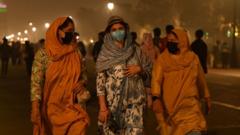In the 2016 Bollywood film *Pink*, Amitabh Bachchan’s character is seen navigating the smog-filled streets of Delhi while wearing a mask. Although these scenes highlight the perilous reality of air pollution, the film primarily centers around legal drama and societal issues, leaving environmental concerns as peripheral elements. Unfortunately, depictions of the lethal air quality that plagues many regions of India fail to resonate in contemporary Indian cinema—a stark contrast to other natural disasters that have inspired numerous films, such as floods in Uttarakhand and Kerala.
Siddharth Singh, author of *The Great Smog of India*, criticizes this oversight, branding it a "big failure" that pollution does not dominate India’s literary and cinematic narratives. Singh observes that while much discourse around air quality exists within academic circles, terms like PM2.5 and SO2 do not connect with the general populace. Renowned author Amitav Ghosh, in his work *The Great Derangement*, similarly laments the absence of climate change themes in contemporary fiction, noting that many have acclimatized to climate adversities, rendering them “weirdly normal” in society.
Documentaries like Shaunak Sen’s *All That Breathes*, nominated for an Oscar in 2022, begin to tackle these subjects. Focusing on human-animal interactions and pollution in Delhi, the film illustrates the profound impacts of climate change within everyday life. Sen posits that storytelling can create effective representation of multifaceted issues surrounding climate change and urban life.
In deliberate contrast, filmmaker Nila Madhab Panda, who pivoted towards mainstream cinema after decades in documentaries, believes art can bridge the gap in communicating climate narratives. His 2019 courtroom drama about a couple's divorce over pollution-related disagreements encapsulates the tension between modern urban living and environmental awareness. Panda remarks, "You can't just make anything unentertaining and show it."
The challenge remains to humanize the statistics. Singh reflects on his struggle to unearth personal narratives behind the staggering pollution figures. While regional literature has begun addressing environmental themes, there is a dearth of contemporary storytelling in English that mirrors this focus. Singh believes that the privileged class often overlooks these critical issues as they live insulated lives far from the polluted waterways and air of cities.
As prevalent as memes and social media humor may be, capturing the gravity of air pollution demands deeper engagement beyond surface-level jokes. Singh envisions these creative expressions fostering a movement that generates responses from those in power to effect real change. Ultimately, addressing the narrative of air pollution through cinema and literature is crucial for igniting awareness and action regarding environmental crises gripping India today.



















